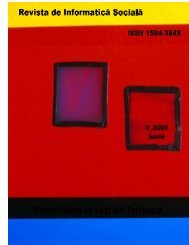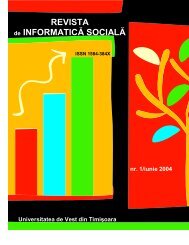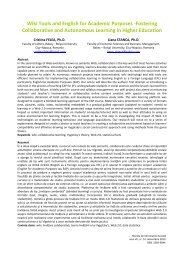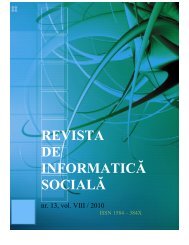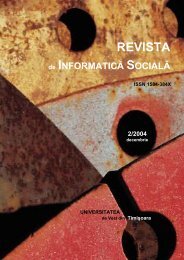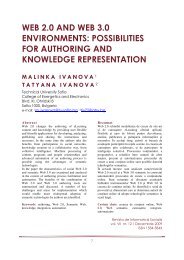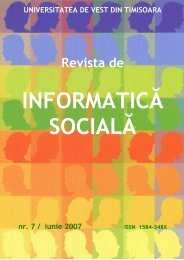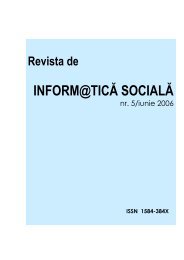that they can get a college-graduate-caliber job and add value in it. Post recession, all U.S. highereducation needs to adopt and scale these practices.Transformed Online Learning is a Part <strong>of</strong> Broa<strong>de</strong>r Institutional StrategiesInstitutional lea<strong>de</strong>rs spent 2008 and 2009 “staunching the flow” <strong>of</strong> the resource impact <strong>of</strong> the GreatRecession. They recognize that they must use 2010-2012 to aggressively leverage stimulus fundingand discover not just efficiencies, but innovations and transformations that will make their coursesmore attractive to stu<strong>de</strong>nts and will enable them to achieve financial sustainability when thestimulus money is gone. Transformed online, blen<strong>de</strong>d and e-learning is one <strong>of</strong> a set <strong>of</strong> even broa<strong>de</strong>rinstitutional strategies to achieve financial sustainability that are mentioned in the white paper,“Linking Analytics to Lifting out <strong>of</strong> Recession.” [6]Jobs, Jobs, Jobs<strong>No</strong>t enough online courses make explicit the links between the content and methods <strong>of</strong> the course,the metaskills honed in the course (learning to learn) and the requirements <strong>of</strong> organizations that mayhire graduates from that course. Faculty should give thought to this. One possible solution is to setup an online discussion space for current stu<strong>de</strong>nts to hear from stu<strong>de</strong>nts in a previous cohort.Another solution is to link stu<strong>de</strong>nts to pr<strong>of</strong>essional communities, so that they can find out how tomake themselves more employable. The general rule is that learning experiences must be moreclosely linked to active, immersive application and to the future workplace. The capacity toperpetually enhance competences and meta-skills to maintain or raise competitiveness is enhancedwith online learning and Web 2.0 tools and patterns <strong>of</strong> interactivity. The building <strong>of</strong> job-relatedcompetences, using online learning and related agile organizational capacities, is likely to be a highpriority in the near-term future and beyond.As we look at the potential <strong>of</strong> online learning and competence building, we should learn frommarket lea<strong>de</strong>rs how to leverage transformation in business mo<strong>de</strong>ls and learning settings, as<strong>de</strong>scribed below.TWO TRANSFORMATIONS IN THE MODELS OF LEARNING AND COMPETENCEBUILDINGIn studying the strategies and actions <strong>of</strong> the market lea<strong>de</strong>rs, one should examine twotransformations that are ongoing and interconnected. These involve the business mo<strong>de</strong>ls andlearning settings <strong>of</strong> online learning. In our view, these dimensions are un<strong>de</strong>rgoing transformationsthat will shake higher education’s world unless institutions take advantage <strong>of</strong> the neworganizational capacities associated with e-learning.First, there is the evolution <strong>of</strong> the business mo<strong>de</strong>ls for institutions and formal learning enterprisesfrom today’s traditional premium price mo<strong>de</strong>l (bundled learning, assessment and certification; afocus on what constitutes a quality education/institution; and traditional roles for faculty) to atransformed mo<strong>de</strong>l (unbundled and re-imagined teaching, learning, assessment and certification;value-based in times <strong>of</strong> scarce resources; re-invented roles for faculty, mentors, instructional<strong>de</strong>signers and peer-to-peer learning; and changing the financial mo<strong>de</strong>l to achieve financialsustainability and lower prices to the consumer).Second, there is the evolution <strong>of</strong> the learning setting from the traditional institutional setting to atransformed, open setting in which “open” inclu<strong>de</strong>s but is not limited to Open EducationalResources (OER) and related resources and practices. Open also means that users have far morechoice today about what they learn (not just prescribed learning pathways, but selected knowledgegaps, based on flows <strong>of</strong> continuously refreshed knowledge), how they learn it, what if anything theypay for it, and who they learn it with/from (e.g. peer-to-peer learning and community <strong>of</strong> practicebasedlearning). Open can mean a combination <strong>of</strong> “free” and “pay a fee.”
Some <strong>of</strong> these transformations are being incorporated in traditional institutional settings, or couldbe. An example is a modular course from the United Nations University and collaboratinguniversities, "Business and Management Competencies in a Web 2.0 World" (http://www.opened.eu),relevant here because stu<strong>de</strong>nts can make precisely the choices outlined above: what theylearn, how, at what cost, with whom, for what kind <strong>of</strong> accreditation. Other transformations areoccurring outsi<strong>de</strong> the realm <strong>of</strong> accredited institutions and formal learning enterprises (e.g.,http://www.khanaca<strong>de</strong>my.org/).So let’s begin by discussing five stages in the transformation <strong>of</strong> the business mo<strong>de</strong>l for onlinelearning. These are presented in the graphic “Evolving Mo<strong>de</strong>ls <strong>of</strong> Learning and CompetenceBuilding.” The horizontal axis represents progressive transformation <strong>of</strong> business mo<strong>de</strong>ls towardgreater value and financial sustainability. The vertical axis represents progressive expansion <strong>of</strong> openlearning practices, both within traditional institutions (represented by the expansion <strong>of</strong> the“institutional arrow” in each successive stage) and in emerging peer-to-peer environments,communities <strong>of</strong> practice, focus on knowledge gaps and flows and “free range learning.”This simplified diagram presents these stages as logical, sequential stages <strong>of</strong> evolution for<strong>de</strong>scribing the current state <strong>of</strong> <strong>de</strong>velopment <strong>of</strong> online practices. The reality is substantially morecomplex. First, individual institutions are not homogeneous and so may <strong>de</strong>monstrate characteristics<strong>of</strong> several stages at any point in time. Second, individual institutions may experience a jump shiftand make a leap from Stage I to Stages III or IV if they achieve strong lea<strong>de</strong>rship, learn from thebest practices <strong>of</strong> others, and <strong>de</strong>velop or acquire infrastructures, processes and competences. Andthird, the boundaries between institutional and open learning experiences will blur as institutionalpractice evolves into States IV and V. Despite these caveats, the mo<strong>de</strong>l clarifies the evolutioncurrently un<strong>de</strong>rway in learning and competence building.
- Page 1: Revista de Informatica Sociala 14 /
- Page 7: ● ● ●CONTENTS● ● ●[9-20
- Page 10 and 11: THE TRANSITION FROM OLD TO NEW MEDI
- Page 12 and 13: 30252023.420.325.11510500.85.5Never
- Page 14 and 15: Overall, we can therefore sum up on
- Page 16 and 17: n.a.I often use itI seldom use it6.
- Page 18 and 19: - Traditional web use: searching th
- Page 20 and 21: 19. Kvavik R.B., Caruso J.B. and Mo
- Page 22: IntroductionIn 1995, Bernie Dodge o
- Page 25 and 26: The Web-Inquiry Project [WIP] is a
- Page 27 and 28: and even orally. The teacher will a
- Page 29 and 30: environment in which the teacher gu
- Page 31 and 32: Transformation Through Online Learn
- Page 33 and 34: INTRODUCTIONLeading practitioners a
- Page 35: learning. We also describe how the
- Page 39 and 40: Recently, Twigg has received suppor
- Page 41 and 42: Stage III: Unbundled Learning, Mark
- Page 43 and 44: perhaps using Second Life-like virt
- Page 45 and 46: performance. Indeed, Stage V will l
- Page 47 and 48: Free-Range Open LearningOver time,
- Page 49 and 50: New communities, tools and services
- Page 51 and 52: Embed enterprise-wide predictive an
- Page 53 and 54: In collaboration with Strategic Ini
- Page 55 and 56: Wiki Tools and English for Academic
- Page 57 and 58: eality. Besides being an additional
- Page 59 and 60: StudentPage 1StudentPage nTeacher
- Page 61 and 62: 100%90%80%70%60%50%40%30%20%10%0%Ac
- Page 63 and 64: 200Correlation View/Page Edits150Vi
- Page 65 and 66: 14. http://eacea.ec.europa.eu/llp/s
- Page 67 and 68: Simularea şi comunicarea electroni
- Page 69 and 70: RespondenţiRăspunsuriLa nivelul
- Page 71 and 72: RespondenţiRăspunsuriLa nivelul
- Page 73 and 74: Respondenţii au fost rugaţi să i
- Page 75 and 76: Itemul 9 doreşte să identifice ti
- Page 77 and 78: Identificara opţiunii, chiar şi p
- Page 79 and 80: EşantioaneRăspunsuri/Ranguriagita
- Page 81 and 82: modalităţile practice prin care u
- Page 83 and 84: 1. INTRODUCEREÎn prezent, complexi
- Page 85 and 86: Figura 1. Analiza grafică a evolu
- Page 87 and 88:
Faţă de această situaţie se deg
- Page 89 and 90:
variabilele acesti noi culturi cybe
- Page 91 and 92:
INTRODUCEREÎncă din anul 2000 am
- Page 93 and 94:
după tipul lecţiei: prezentare de
- Page 95 and 96:
Funcţiile oferite de AEL asigură
- Page 97 and 98:
• elevi/studenţi, beneficiari di
- Page 99 and 100:
Se poate folosi cadrul formal de co
- Page 102 and 103:
Evaluarea formativă este comentari
- Page 104 and 105:
Rezultatele elevilor, pe itemi:Diag
- Page 106 and 107:
Nr. Denumirea activităţii AEL MOO
- Page 108 and 109:
SEMNAL EDITORIALLaura MALITA, Vanna
- Page 110:
IN MEMORIAMConstantin TraianCHEVERE



